#19: Barnet, Barnet, so good they named it in several contradictory ways
Ed Jefferson is attempting to visit every Mews in Greater London. This week: Nebraskan cheerleaders, morbid kebab shops and yet another protest group starts a micronation.
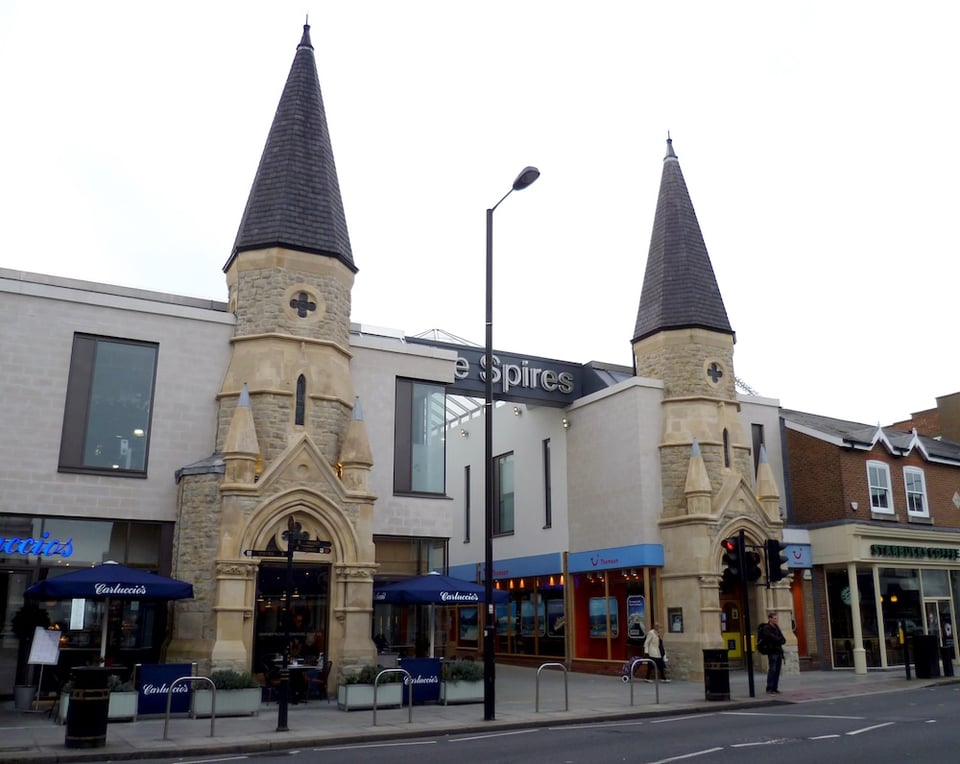
Where, and what, actually is Barnet? That there is no obvious answer to this must be perturbing for those who may or may not be living there.
To begin: what was in effect the town of Barnet before it was subsumed into Greater London is also often called Chipping Barnet, the Chipping bit meaning ‘place with a fair’, but also sometimes High Barnet (because it’s on a hill), hence the name of the tube station. To make things even more confusing, High Barnet is also the name of a council ward (which helpfully doesn’t contain High Barnet station), sitting within the parliamentary constituency of Chipping Barnet. Just to confuse matters further, this constituency also includes the distinct and equally unhelpfully named suburbs of Friern Barnet, East Barnet and New Barnet.
To make matters worse, all of these places also sit within the London borough of Barnet, created in 1965, and mostly comprised of places that aren’t Barnet. While three of the five councils that merged to form the borough had the word Barnet in their names, almost half of the population lived in Hendon, so were presumably confused to find out that they now lived somewhere else entirely.
A lot of different names for the borough were proposed - Hendon initially favoured Hendon, for obvious reasons, but beyond that there seemed to be a vague agreement on something neutral and ‘North’ themed - suggestions included North Hills, Northern Heights and Northgate. But for some reason Barnet got picked by the powers that be (Reginald Maudling, Chipping Barnet’s MP, was the chancellor at the time so one could surmise that there was some sucking up going on) and eventually everyone got sick of arguing about it and accepted the name.2 So sod it, let’s just say that everything is Barnet now. You are Barnet, I am Barnet, we are all Barnet together. Goo goo g' joob.
Now we just need to figure out why anyone would bother using Barnet Fair as rhyming slang for hair. Or any rhyming slang at all. Get a real hobby, like squinting at maps from the 1900s and trying to work out when and why the street numbers might have changed very slightly.
The Mewses
#181 Bridle Mews, Barnet, EN5

Everyone playing the Mews drinking game, have a shot for a horse-related Mews name - and another for some plausible historical basis for it. Though the name may not itself be very old, an advert from 1894 advertises the services of Edward White, “Job & Riding Master”, based at the building on the western side of the mews - you could hire carriages and horses, and get lessons in how to use these things together3. On the other side was the premises of J. A. Clark, offering the combined services of Haberdashery and, er, undertaking - "Funerals Personally Conducted at Moderate Charges". It’s now a kebab shop. I’m saying nothing.
#182 Leinster Mews, Barnet, EN5
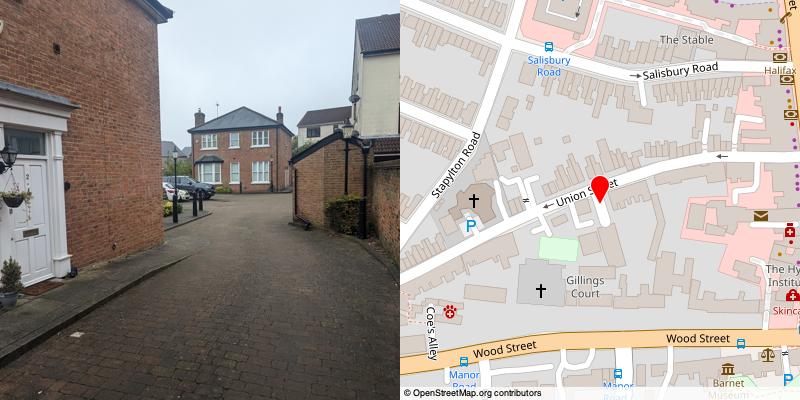
Early 2000s development on the site of the hall formerly occupied by the “Barnet Centre of Fellowship”, a Christian Spiritualist church for people who love Jesus AND having a medium ask if the colour red means anything to anyone.
#183 Hadley Mews, Barnet, EN5
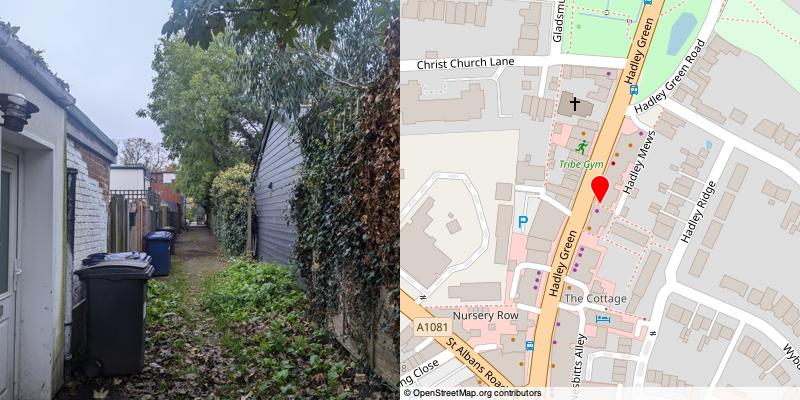
This Mews - basically just an alleyway with a few residences built in the gardens of the houses behind - lies at the top of Barnet High Street, where London really starts to thin out - the name ultimately derives from the village of Monken Hadley to the north, home to various vast piles including a mansion that once belonged to Spike Milligan. You can’t get the wood, you know!
#184 Aran Mews, Barnet, EN5
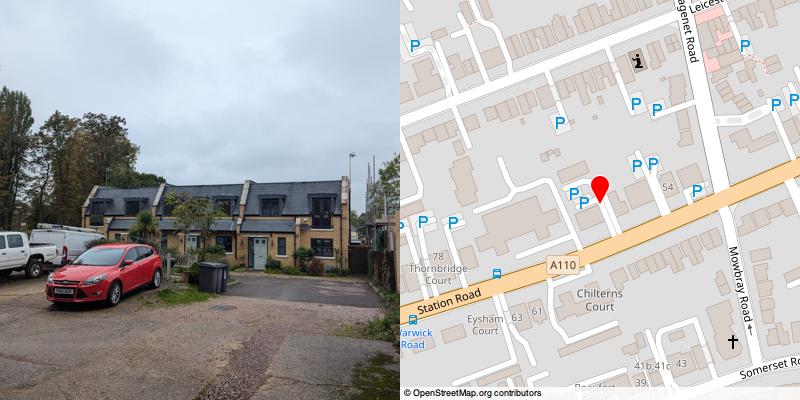
2000s infill behind a post-war apartment block called Hanover House. Dunno why ‘Aran’, unless someone mistakenly thought Hanover was also an island off Galway.
#185 Battle House Mews, Barnet, EN4
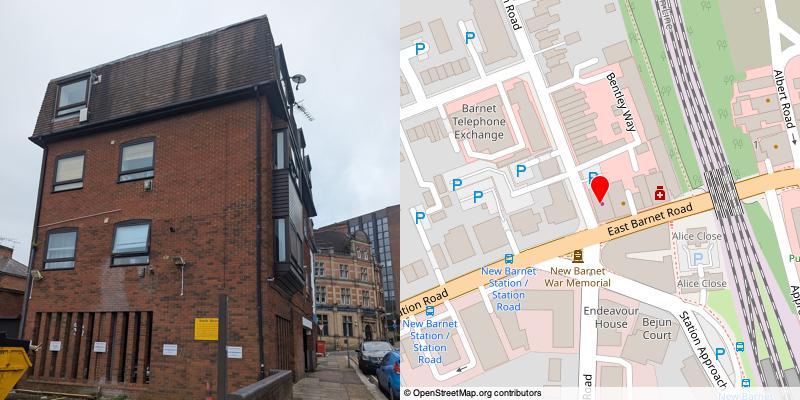
Lesser spotted vertical mews - the ‘mews’ is actually flats converted from offices in the upper part of Battle House, though it took some wandering around to convince myself that this was the case (and trying to assure people that I wasn’t lost actually without actually confessing what I was doing), which I confirmed by checked the planning documents from when they applied for change of use. Anyway, ideal for if you’ve ever wanted to live above a Betfred.
#186 Astera Mews, Barnet, EN4

As far as I can tell ‘Astera’ is derived from the Greek for star, though it mainly seems to be used as the name for Greek restaurants.
Development was opposed by former MP Theresa Villiers, who for some reason didn’t think building new homes in London was a good idea, despite the fact that she loved having a home in London so much she claimed expenses for two different ones, on the grounds that sometimes she couldn’t be arsed to get back to Zone 5.
Local objections included things like: “it is an attempt to squeeze a quart into a pint pot” and honestly councils should be obliged to accept planning applications once any bothers to write shit like that. Anyway, the application was rejected, but the developer resubmitted it with 8 houses instead of 9, which made it all okay apparently. I’ve looked up what a quart actually is and this means the result is like squeezing 1 and 7/9ths pints into a pint pot.
#187 Oakleigh Mews, Barnet, N20
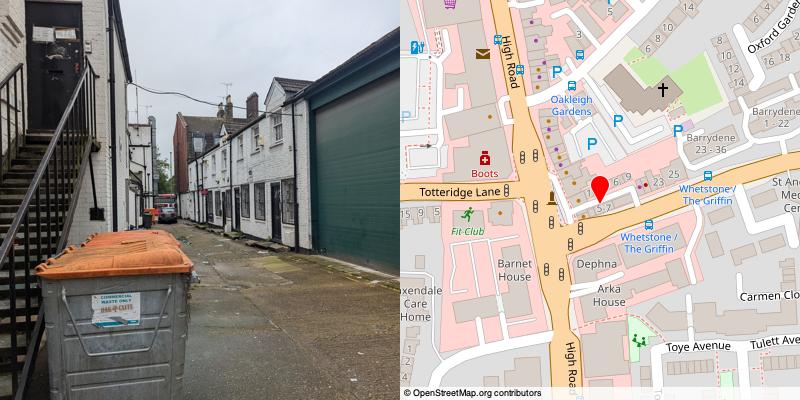
As a named road dates to at least the 1890s - in 1895 a report from the local sanitary inspector ordered ‘alterations to manure pits’ which doesn’t sound great to start with. The owners refused to follow further official guidance on making the mews sanitary - the newspaper report is slightly unclear on this but it sounds like one of the basements was filling with sewage - so Friern Barnet local board (the thenadays equivalent of the council, effectively) had to step in and fix the problem before billing the owners from the costs. And you thought your landlord was bad.
#188 Foxley Mews, Barnet, N20

Foxley Mews is just one road of a substantial 2010s housing development on land with a somewhat varied history. Once used to graze cows, it became a nursery in the 19th century, most successfully under owner James Sweet, who grew flowers and grapes in rows of greenhouses here and is remembered in the road ‘Sweets Way’ to the south.
The nursery was requisitioned by the army and used for anti-aircraft guns, then after the war an estate of houses for military families was built in its place. Then, 1996 the MoD decided it would be a good idea to sell all their houses (about 57 thousand of them across the country) to a company called Annington, then rent back the ones they still needed, which turned out to be quite a bad deal as a) you may have noticed that houses are worth quite a lot more now than they were in 1996 and b) the contract with Annington resulted in the taxpayer paying rent for property the MoD didn’t need, paying for refurbishment for properties it didn’t own, and having to rent other property elsewhere while that happened. The deal was so crap that there are legal battles going on over it to this day.
Meanwhile, back in Barnet, the estate on Sweets Way was deemed surplus to military requirements and so was instead used as social housing - generally on a temporary basis. The main reason for this was that Annington wanted to be able to turf tenants out a short notice, knock down the houses and build the shiny new ones on the site today.
When evictions began in 2015, a resistance movement quickly sprang up, in the wake of a general outcry about social housing being ‘regenerated’ for profit - in Sweets Way residents refused to leave because they were being offered alternative accommodation that was more expensive, miles away, unsuitable for their needs, miles away and/or in a worse condition. As if that wasn’t bad enough, then Russell Brand turned up to help.
Brand, now at best a salesman of charms to protect you from WiFi and at worst accused of various far more unpleasant things, was then in his ‘leftwing radical’ phase, and did succeed in drawing more attention to the cause - as more people turned up to join the movement, defensive walls were constructed and the group declared itself to be the independent state of Sweetstopia (hmm, another London micronation for list).
According to a contemporary report by John Rogers, visitors were invited to make their own passports and get them marked as official using a stamp made from potato, as long as they agreed not to knit after dark or feed unicorns. (A Guardian report from the time notes that not everyone was charmed by this kind of thing, with some former residents clearly a bit suspicious that people had just turned up to have a big piss up and paint rude words on the walls.4)
The end result: a massive eviction of the protestors, including the last remaining tenant, wheelchair user Mostafa Aliverdipour, who reported that he would now have to live in his car due to the unsuitability of the alternative accommodation being offered. Seems ideal!
The new estate, is on its own merits, fairly average. Due to woke it has lots of solar panels and places to charge electric cars, and also has lots of pathetic signs warning intruders that this is all private and that there are no through routes, even though there are loads of through routes. They are so eager to stop Mews perverts wandering about that the pedestrian entrance off the main road is hidden behind a bin store. Grow up.
#189 Lilia Mews, Barnet, N20
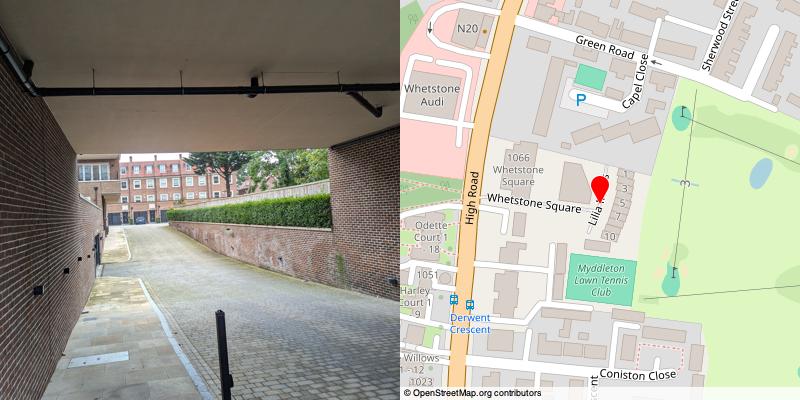
Fairly new row of executive townhouses (whatever that means) behind a larger apartment block - all built as a single development called Whetstone Square - this being in the suburb of Whetstone (as in Totteridge & Whetstone if you’ve ever contemplated the northern end of the Northern Line). This is marked by a big stone out the front, which I am suspicious of.
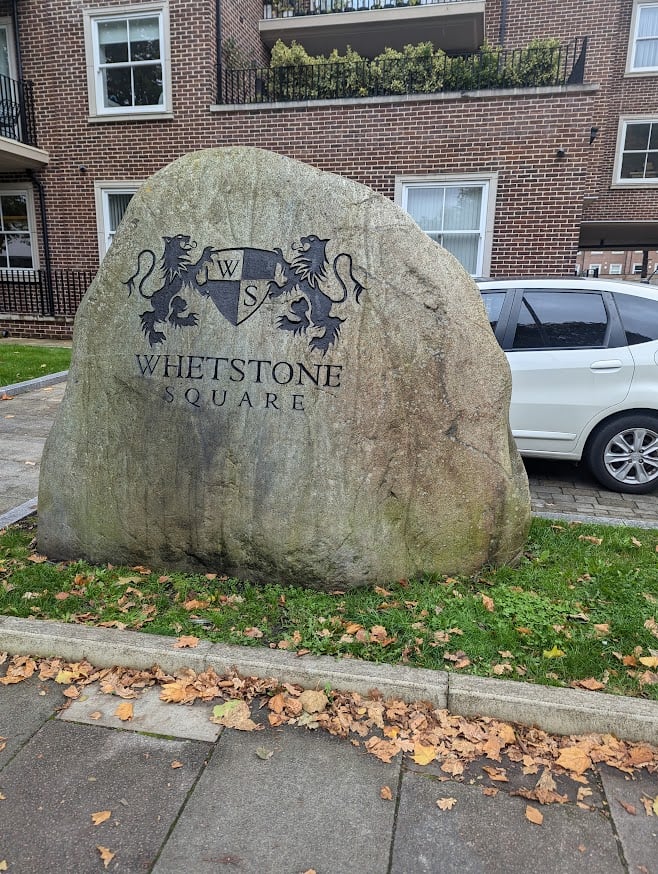
There’s another, much smaller, stone by the crossroads north of here, just outside a pub called The Griffin, usually referred to as ‘the Whetstone’ and reputed to have some sort of historical pedigree, perhaps connected to the name of the area.

A whetstone is a stone used to sharpen steel, and local legend would have it this one was used to prepare swords for the Battle of Barnet (which actually mostly took place in Monken Hadley, but let’s not start all that again). Actual fact can’t explicitly confirm or deny this, but it seems more likely that it is a) not that old5 and b) was mainly just used to help people get off their horses. Whetstone as a place name seems likely to have instead derived from ‘West Town’.
Either way, putting a big stone outside your housing development in Whetstone feels like an attempt to steal valour, and I think the new stone should be forced to write a handwritten letter of apology to the old stone.
#190 Elkanette Mews, Barnet, N20
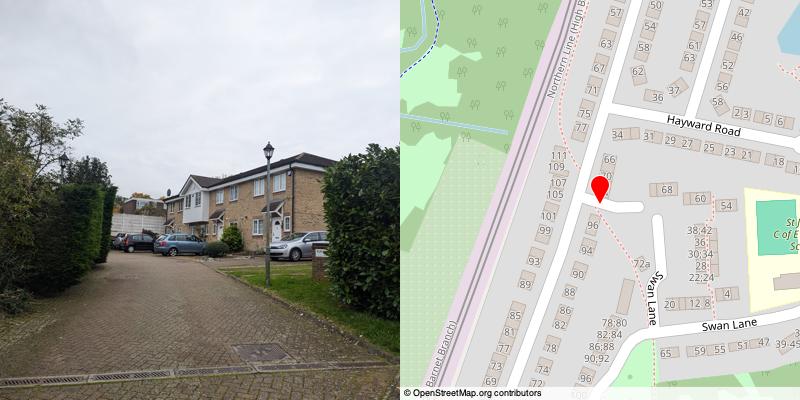
Redeveloped from what was a house with a builder’s yard behind in the mid-90s, which must have been a blessing for postmen as the old house was number 100 and lay between numbers 74 and 98.
One question: what the hell is an elkanette? The only reference to this word I can find is that Elkhorn High School in Omaha, Nebraska, USA, has, or at least had, a “drill team” called the Elkanettes. I think this is sort of like cheerleaders as it’s also described as a pom pom and flag squad: “They dance. They yell,” - Omaha World Herald, 1988. Why on Earth a road in Barnet would be named after them I do not know - answers on a flag?
Mewses Visited So Far: 190/2380
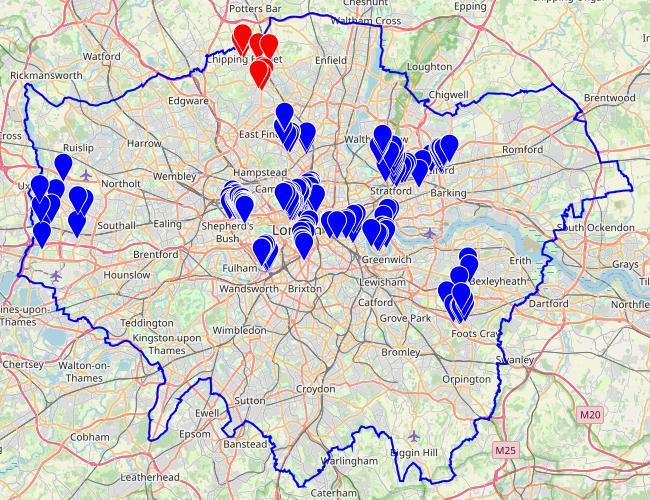
It’s called The Spires, but it isn’t on a Mews so I haven’t bothered learning anything else about it. ↩
See the excellent LCC Municipal blog for a lot more detail on this and the naming of other London boroughs. ↩
Though perhaps he didn’t keep any horses here after all - the ad says his stables were based at the Red Lion, an extant pub just down the road. ↩
Navigating this sort of thing seems to be something of a theme for these protests - the ‘state’ of Wanstonia, set up to protest the building of the M11, expelled ‘lunch outs’, who it was felt were more interested in drinking than protesting (see Mews Letter #11). ↩
The earliest evidence for its existence is from the 18th century. ↩
Add a comment: